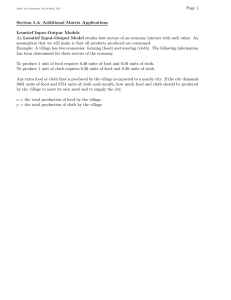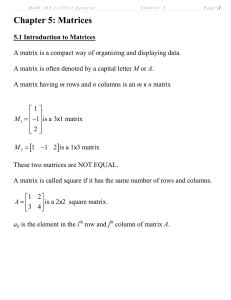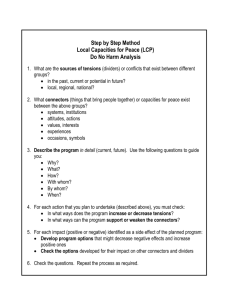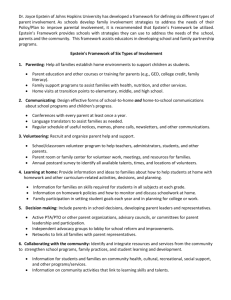2.7 Leontief Input-Output Model weaving.
advertisement
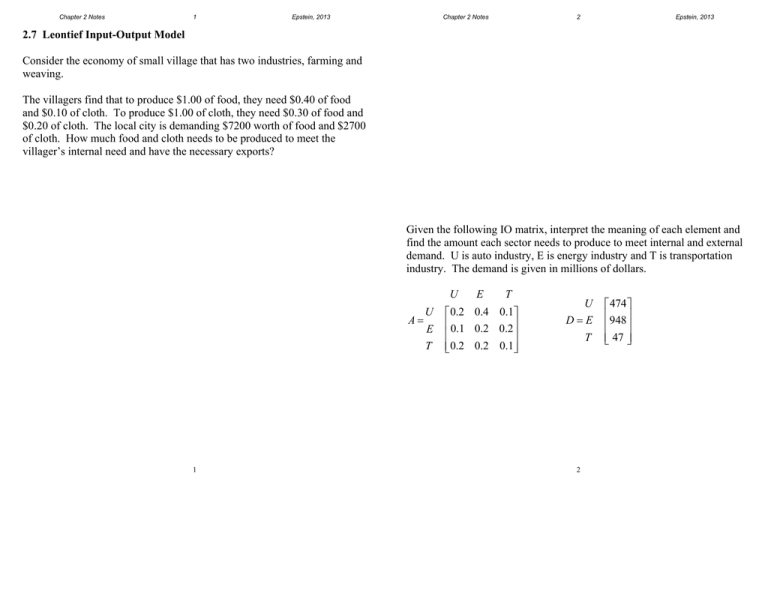
Chapter 2 Notes 1 Epstein, 2013 Chapter 2 Notes 2 Epstein, 2013 2.7 Leontief Input-Output Model Consider the economy of small village that has two industries, farming and weaving. The villagers find that to produce $1.00 of food, they need $0.40 of food and $0.10 of cloth. To produce $1.00 of cloth, they need $0.30 of food and $0.20 of cloth. The local city is demanding $7200 worth of food and $2700 of cloth. How much food and cloth needs to be produced to meet the villager’s internal need and have the necessary exports? Given the following IO matrix, interpret the meaning of each element and find the amount each sector needs to produce to meet internal and external demand. U is auto industry, E is energy industry and T is transportation industry. The demand is given in millions of dollars. U U A E T 1 E T 0.2 0.4 0.1 0.1 0.2 0.2 0.2 0.2 0.1 U DE T 2 474 948 47 Chapter 2 Notes 3 Epstein, 2013 Chapter 2 Notes 4 Example The Acme Candle Company produces 30,000 jar candles per week. The production of these candles is done in three departments: blending, filling, and packaging. These production departments are supported by two service departments: custodial and maintenance. In determining the total cost to produce the candles, there are both direct costs from the production departments along with the indirect costs from the supporting service departments. The direct costs are known. These are the costs for the employees' salaries and for materials. The direct costs for the custodial are $1500, for maintenance $2000, for blending $11,000, for filling $12,000, and for packaging $6400. The custodial staff spends 10% of its time servicing its own areas, 5% on servicing the maintenance areas, and 25% of the time on each of the production areas. The maintenance department spends 10% of its time maintaining the custodial equipment, 15% maintaining their own equipment and then 35%, 25%, and 20% in the blending, filling, and packaging departments, respectively. Determine the total cost of each department. 3 4 Epstein, 2013 Chapter 2 Notes 5 Epstein, 2013 Chapter 2 Notes 6 Epstein, 2013 Closed Leontief Input-Output Model Example The RainMan Company makes sprinklers. Each sprinkler head is made from 4 straight connectors, 1 elbow connector, and 1 T-connector. The elbow connectors are made from two straight connectors. The Tconnectors are made from 3 straight connectors. If the company has a demand for 20 sprinkler heads, 15 T-connectors, 10 elbow connectors, and 25 straight connectors, how many of each part should be made to meet the demand? In the closed input-output model, we assume that there is no demand from outside the n industries under consideration. Let fij be the fraction of the total output of the jth industry purchased by the ith industry. The problem then is to find suitable prices for each of the n outputs so that the total expenditure of each industry equals its total income. Any such price structure represents equilibrium for the economy. Let pi be the price charged by the ith industry for its total output. For convenience, consider an isolated island with three sectors: farming, building and services. As usual, we allow for the possibility that each industry consumes (and therefore buys) some of its own product. To produce 1 unit from the farming sector it takes ½ unit of farming, 1/3 unit of building and 1/6 unit of services. To produce 1 unit of building requires 1/3 unit of farming, 1/3 unit of building, and 1/3 unit of services. To produce 1 unit of services requires ¼ unit of farming, ¼ unit of building and ½ units of services. What are the equilibrium prices for these three sectors? 5 6

